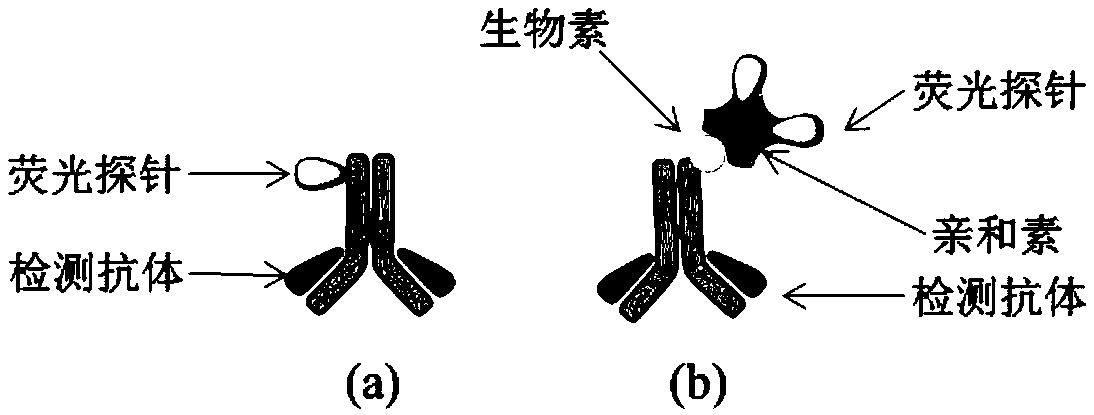Method for ultra-sensitively detecting small molecular substances
A technology for sensitive detection of small molecular substances, applied in the biological field, can solve problems such as low sensitivity and inability to perform multiple detection, and achieve the effects of improving detection sensitivity, improving fluorescent labeling efficiency, and simple synthesis process
- Summary
- Abstract
- Description
- Claims
- Application Information
AI Technical Summary
Problems solved by technology
Method used
Image
Examples
Embodiment 1
[0026] The small molecular substances detected by the method of the present invention refer to substances that can be recognized by other substances through specific actions, such as antigens that can be recognized by antibodies, ligands that can be recognized by receptors, substrates that can be recognized by enzymes, and substances that can be recognized by antibodies. Polysaccharides recognized by lectins, biotin that can be recognized by avidin or streptavidin. Because the principle is the same, take the antibody-antigen immune reaction as an example to prove that there is a theoretical minimum value in the sensitivity (half-inhibitory concentration, IC50) of competitive immunoassay, and the sensitivity of competitive immunoassay can be improved by reducing the concentration of competitors and the concentration of detection antibodies, so that It is close to the theoretical limit.
[0027] Through mathematical modeling, a theoretical model was established to study competit...
Embodiment 2
[0058] Embodiment 2 The method for detecting small molecules of the present invention
[0059] The small molecular substances detected by the method of the present invention refer to substances that can be recognized by other substances through specific actions, such as antigens that can be recognized by antibodies, ligands that can be recognized by receptors, substrates that can be recognized by enzymes, and substances that can be recognized by other substances. Polysaccharides recognized by lectins, biotin that can be recognized by avidin or streptavidin. Because the principle is the same, this embodiment takes the detection of antibody-antigen immune reaction as an example to illustrate the method for ultrasensitive detection of small molecular substances of the present invention.
[0060] When the small molecule is a hapten, the method for detecting the hapten comprises the following steps:
[0061] 1. Preparation of hapten-labeled solid phase support
[0062] The solid ...
Embodiment 3
[0073] Embodiment 3 adopts the inventive method to detect aflatoxin B1
[0074] 1. Materials and Methods
[0075] Bovine serum albumin (BSA), bovine serum albumin-aflatoxin B1 conjugate (BSA-Aflatoxin B1), aflatoxin B1 acetonitrile solution, PBS buffer, tris(hydroxymethyl)aminomethane (Tris), chloride Sodium (NaCl), ethyl[3-(dimethylamino)propyl]carbodiimide hydrochloride (EDC), 2-(N-morpholine)ethanesulfonic acid (MES), Tween-20 were purchased from Sigma Corporation. Aflatoxin B1 monoclonal antibody (disclosed in Journal of Immunological Methods 329 (2008) 112-124). Dynabeads TM MyOne TM Carboxyl-modified magnetic beads (hereinafter referred to as carboxyl-modified magnetic beads) and Alexa 647 active ester was purchased from American Thermofisher Company.
[0076] 2. Specific methods for detecting aflatoxin B1
[0077] (1) Preparation of hapten-labeled magnetic beads
[0078] Take 100 μL of carboxy-modified magnetic beads (10 mg / mL, 1 μm in diameter) in a 1.5 mL ce...
PUM
| Property | Measurement | Unit |
|---|---|---|
| diameter | aaaaa | aaaaa |
| diameter | aaaaa | aaaaa |
| recovery rate | aaaaa | aaaaa |
Abstract
Description
Claims
Application Information
 Login to View More
Login to View More - R&D
- Intellectual Property
- Life Sciences
- Materials
- Tech Scout
- Unparalleled Data Quality
- Higher Quality Content
- 60% Fewer Hallucinations
Browse by: Latest US Patents, China's latest patents, Technical Efficacy Thesaurus, Application Domain, Technology Topic, Popular Technical Reports.
© 2025 PatSnap. All rights reserved.Legal|Privacy policy|Modern Slavery Act Transparency Statement|Sitemap|About US| Contact US: help@patsnap.com



